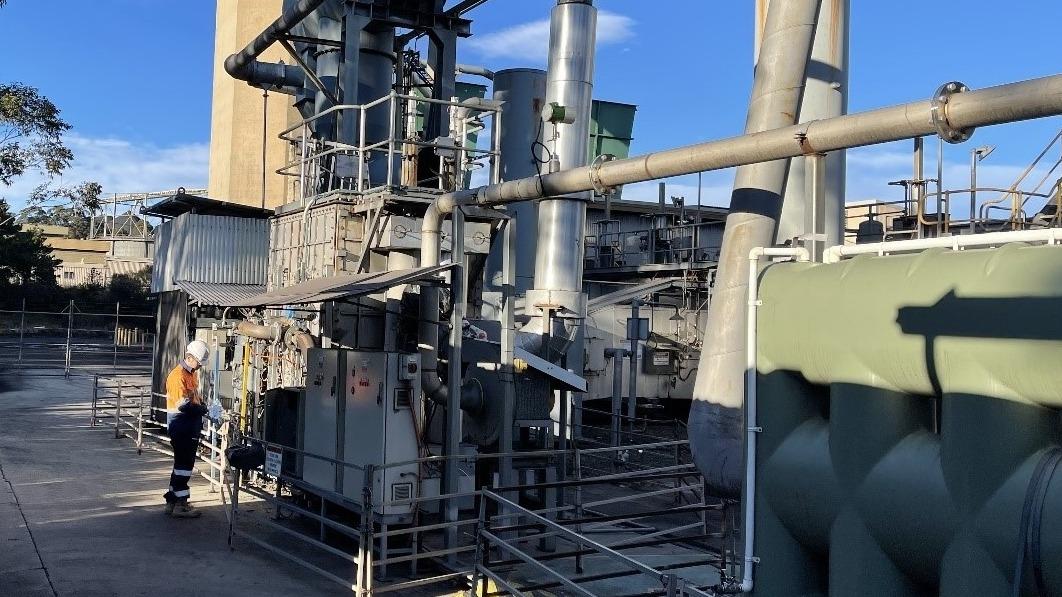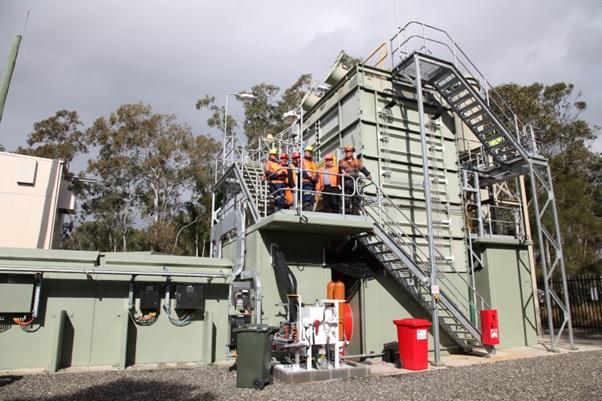Fugitive methane emissions from coal mines
Why methane emissions?
Methane is a potent greenhouse gas. Methane is commonly formed underground during a natural process where organic plant materials are converted into coal. The gas is stored within coal seams and surrounding rock strata and can be released due to natural processes or mining operations.
Fugitive emissions from coal mining account for 8.9% of NSW greenhouse gas emissions (Scope 1 emissions in 2022). Most of these emissions are from underground coal mines in the form of ventilation air methane (VAM). VAM is very challenging for the coal industry to mitigate or use as an energy source because the air volume is large, and the methane resource is dilute and variable in concentration.
Project: Full-scale ventilation air methane abatement facility
The challenge:
Overcome challenges of commercial scale VAM abatement and encourage industry uptake of the technology.
The action:
Coal Innovation NSW funded the VAM abatement demonstration project at a NSW coal mine.
Grant amount:
$15 million.
The project:
South 32 will design and construct a full-scale next generation VAM mitigation thermal reactor (termed a VAMMIT unit) demonstrated with improved safety and commercial viability. Long term testing of the technology and safety system will be conducted with results summarised and presented to the NSW Government and mining industry.
CSIRO has previously successfully trialled smaller-scale VAM technology at the Appin coal mine in southern NSW. Project success at full commercial scale would encourage broader industry uptake of this technology and drive emissions reduction from the sector.
VAM thermal reactor technology works by oxidising almost all the methane (>99%) in a combustion chamber heated to approximately 1000º Celsius. At this temperature the methane is converted to water and carbon dioxide (CO2), which has a significantly lower Global Warming Potential (GWP) than methane. A key feature of the technology is its ability to be self-sustaining as it doesn’t need additional energy to maintain the temperature in the combustion chamber.

VAMMIT pilot plant at Mandalong (courtesy of CSIRO)
Project: Ventilation air methane (VAM) catalytic mitigator
The challenge:
Investigate novel technologies to reduce the VAM emissions from coal mining operations.
The action:
Coal Innovation NSW funded the design, development and pilot-scale site trial of a novel system that converts methane contained in VAM emissions in an underground coal mine into carbon dioxide (a less potent greenhouse gas) through catalytic oxidation.
Grant amount:
Up to $1.5 million (EOI Round 2018).
The project:
This project further developed a novel CSIRO technology, termed a VAM mitigator (VAMMIT), that reduces methane emissions from underground coal mines by converting it into carbon dioxide through a process of catalytic oxidation. It is estimated that VAM may contribute up to 15% of Australia’s total greenhouse gas emissions, and that replacement of methane by carbon dioxide can yield a significant positive response to national greenhouse gas commitments. In comparison, carbon dioxide’s 100-year global warming potential is only 4% of that of methane, meaning that carbon dioxide’s ability to trap heat in the atmosphere is significantly lower than methane.
This project aimed to improve current commercially available VAM conversion systems that use thermal oxidation, which is an extremely high temperature process (~1000°C) that may pose safety concerns for mine site implementation and has high maintenance requirements. The new catalytic conversion system is capable of operating at lower temperatures, processing higher flow rates at lower VAM concentrations, and requiring less input power, making it an attractive potential alternative to thermal oxidation systems.
CSIRO have developed a new reactor with a bed structure comprised of high-performing catalytic materials on a monolithic ceramic substrate through which the VAM is passed and converted into carbon dioxide. A pilot-scale VAMMIT system comprising a catalytic reactor and pipework to deliver actual ventilation for the trials was built and installed at South 32’s Appin mine in southern NSW.
The performance of the pilot plant was tested for a total of 476 hours using real ventilation air from the mine at various VAM concentrations ranging from 0.08 to 0.38% and three ventilation air flow rates of 0.33, 0.50 and 0.67 m3/second. The catalytic VAMMIT was self-sustaining at 0.13% VAM and ventilation air flow rates of 0.50 and 0.67 m3/second with a methane oxidation efficiency in the range of 84-90%. Importantly, the reactor temperature remained stable at 440-550°C, as did catalyst performance with no notable deterioration in performance.
Although testing found that the methane oxidation efficiency of catalytic conversion systems was slightly lower than that achieved with thermal systems, the reasons for the reduction were identified and the predicted advantages of catalytic conversion were demonstrated.
This has been the first on-site demonstration of a catalytic flow reserve reactor capable of self-sustainably processing 0.1 vol % VAM. This is significantly lower than the minimum VAM concentration currently required by commercial reactors Hence, the catalytic VAMMIT provides a technical solution for mine sites with low VAM concentrations.
This study has aided the development and optimisation of catalytic oxidation technology necessary for commercial-scale implementation.
Read the full CSIRO S32 Project final report (PDF, 3.97 MB)
Project: Greenhouse Gas Abatement Facility Demonstration
The challenge:
Investigate new technologies to reduce the methane emissions that can escape from coal mining.
The action:
Coal Innovation NSW funded the trial of a Ventilation Air Methane Regenerative After Burner (VAM-RAB) technology.
Grant amount:
Up to $2.2 million (EOI Round 2009).
The project:
Centennial Mandalong Pty Ltd received funding to trial a new technology called a Ventilation Air Methane Regenerative After Burner (VAM-RAB).
This technology oxidises almost all the methane (>99%) in a combustion chamber heated to approximately 1000º Celsius. At this temperature the methane is converted to water and carbon dioxide (CO2), which has a significantly lower Global Warming Potential (GWP) than methane. A key feature of the technology is its ability to be self-sustaining as it doesn’t need additional energy to maintain the temperature in the combustion chamber.
A demonstration plant was constructed at Mandalong mine to test the technology. Initial heat-up trials in 2014 revealed issues with the plant requiring an extensive remedial works to recommission the plant. However, the heating trials remained unsuccessful, as the required temperatures were not reached.
In early 2019, the project ceased by agreement of all parties, with a commitment to work with the Commonwealth and industry to navigate a pathway to the commercial deployment of VAM abatement technologies. The project highlighted the safety issues involved in abating VAM. Subsequently, a separate, Commonwealth funded project was able to achieve a safe design installation of VAM abatement technologies at an active mine site.

VAMRAB pilot plant at Mandalong (courtesy of CINSW)